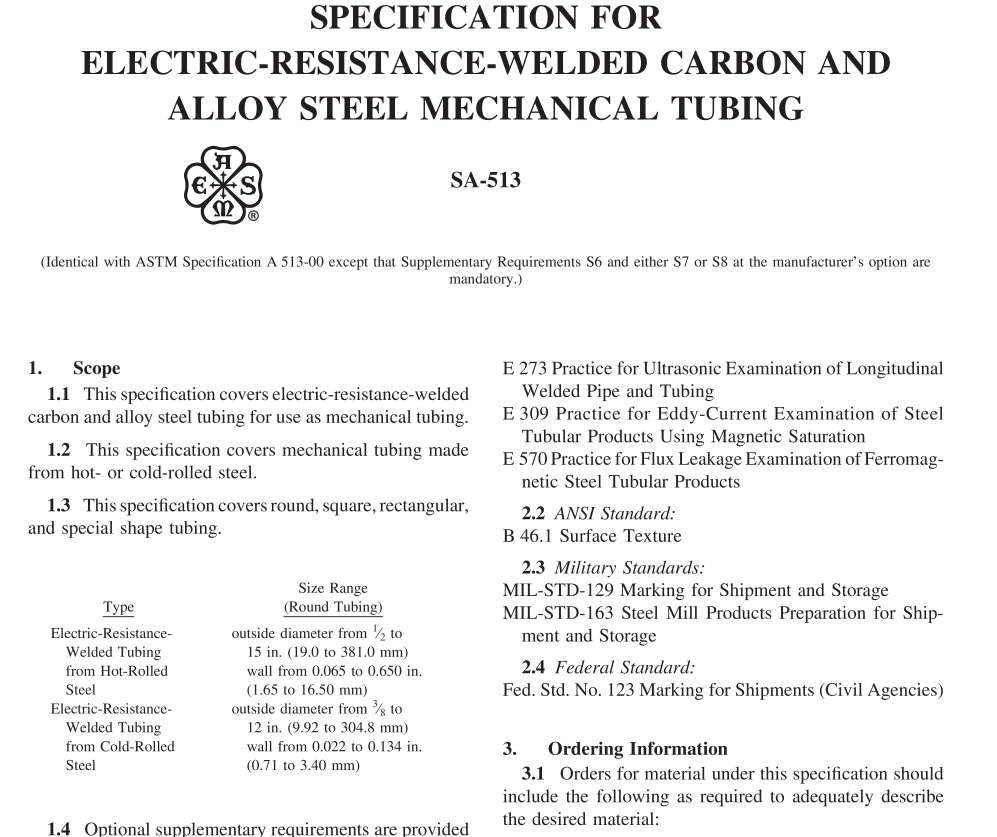ASME SA-513 pdf download

ASME SA-513 pdf download SPECIFICATION FOR ELECTRIC-RESISTANCE-WELDED CARBON AND ALLOY STEEL MECHANICAL TUBING
4. Materials and Manufacture
4.1 The steel may be made by any process.
4.2 If a specific type of melting is required by the purchaser, it shall be as stated on the purchase order.
4.3 The primary melting may incorporate separate degassing or refining, and may be followed by secondary melting, such as electroslag or vacuum-arc remelting. If secondary melting is employed, the heat shall be defined as all of the ingots remelted from a single primary heat.
4.4 Steel may be cast in ingots or may be strand cast. When steel of different grades is sequentially strand cast, identification ofthe resultanttransition material is required. The producer shall remove the transition material by an established procedure that positively separates the grades.
4.5 Tubes shall be made by the electric-resistance- welded process and shall be made from hot- or cold-rolled steel as specified.
5. Chemical Composition
5.1 The steel shall conform to the requirements as to chemical composition prescribed in Tables 1 and 2. If no grade is specified, Grades MT 1010 to MT 1020 may be furnished. Analyses of steels other than those listed are available. To determine their availability, the purchaser should contact the producer.
5.2 When a carbon steel grade is ordered under this specification, supplying an alloy grade that specifically requires the addition ofany element other than those listed for the ordered grade in Tables 1 and 2 is not permitted.
6. Heat Analysis
6.1 An analysis of each heat of steel shall be made by the steel manufacturer to determine the percentages of the elements specified; if secondary melting processes are employed, the heat analysis shall be obtained from one remelted ingot or the product of one remelted ingot of each primary melt. The heat analysis shall conform to the requirements specified, except that where the heat identity has not been maintained or where the analysis is not suffi- ciently complete to permit conformance to be determined, thechemicalcompositiondeterminedfromaproductanaly- sis made by the tubular manufacturer shall conform to the requirements specified for heat analysis. When requested in the order or contract, a report of such analysis shall be furnished to the purchaser.
7. Product Analysis
7.1 When requested on the purchase order, a product analysis shall be made by the supplier. The number and source of samples for such product analysis shall be based on the individual heat or lot identity ofone ofthe following forms of material:
7.1.1 Heat Identity Maintained—One product analy- sis per heat shall be made on either the flat-rolled stock or tube.
7.1.2 HeatIdentityNotMaintained—A productfrom one tube per 2000 ft (610 m) or less for sizes over 3 in. (76.2 mm), and one tube per 5000 ft (150 m) or less for sizes 3 in. and under.
7.2 Samples for product analysis except for spectro- chemical analysis shall be taken in accordance with Prac- tice E 1806. The composition thus determined shall correspond to the requirements of Tables 1-3.
7.3 If the original test for product analysis fails, retests of two additional lengths of flat-rolled stock or tubes shall be made. Both retests for the elements in question shall meet the requirements of the specification; otherwise, all remaining material in the heat or lot shall be rejected or, at the option of the producer, each length of flat-rolled stock or tube may be individually tested for acceptance. Lengths of flat-rolled stock or tubes which do not meet the requirements of the specification shall be rejected.
8. Permissible Variations in Dimensions for Round Tubing
8.1 Diameter and Wall Thickness (Hot-Rolled Steel) — Variations from specified outside diameterfor “as-welded”and “as-welded and annealed” tubing made from hot-rolled steel shall not exceed the amounts prescribed in Table 4. Permissible variations in outside diameter for tubing that has been sink-drawn for closer tolerance on outside diame- ter are shown in Table 5. Permissible variations in wall thickness for tubing that has been sink-drawn for closer tolerances on outside diameters are ±10% of the nominal wall or±0.010 in. (0.25 mm), whichever is greater. Permis- sible variations in wall thickness for tubing made from hot-rolled steel are shown in Table 6. Permissible variation in outside and inside diameter for tubing made from hot- rolled steel that has been mandrel drawn for closer toler- ances are shown in Table 5 with wall tolerances shown in Table 7.









